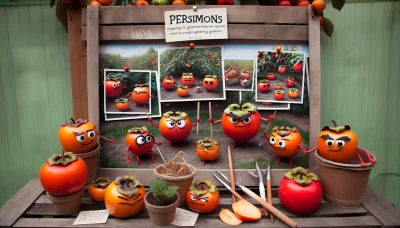How to peel a kiwi fruit Quiz
Test Your Knowledge
Question of
How to Peel a Kiwi Fruit: A Gardener's Guide
Kiwi fruit, a nutrient-packed berry with a vibrant green interior and a fuzzy brown skin, holds a special place in the hearts of gardeners and fruit lovers alike. Not only does it add a tropical flair to any garden, but it also offers a delicious reward for the gardener's efforts. Peeling a kiwi fruit might seem straightforward, but there are techniques to do it efficiently without wasting any of its precious flesh. This guide will explore various methods, from the traditional knife peeling to the innovative spoon technique, ensuring you get the most out of your kiwi fruit.
Choosing the Right Kiwi Fruit for Peeling
When it comes to selecting the best kiwi fruits from your garden for peeling, two key factors to consider are ripeness and variety. A ripe kiwi should yield slightly to gentle pressure, similar to a ripe peach. It's important not to choose kiwis that are too soft, as they might be overripe. On the other hand, kiwis that are too hard may not have reached their peak sweetness and flavor, making them less ideal for eating fresh. The variety of kiwi also plays a significant role in selecting the right fruit for peeling. Some varieties, such as the Hardy or Hayward, are known for their sweet and tangy flavor, which is enhanced when fully ripe. These varieties also tend to have a more uniform shape, making them easier to peel. By paying attention to these details, you can ensure that you pick the best kiwi fruits from your garden for a delicious and nutritious snack.
Preparation Before Peeling
Before peeling a kiwi fruit, it's important to properly prepare it to ensure cleanliness and ease the peeling process. Start by thoroughly washing the kiwi under cold running water to remove any dirt or pesticides from the skin. It's recommended to use a soft brush to gently scrub the surface if the kiwi is particularly dirty. After washing, pat the kiwi dry with a clean towel. Next, gather the tools you will need for peeling. A sharp paring knife or a vegetable peeler works best for removing the skin with minimal waste. Having a cutting board will also provide a stable surface to work on and help in neatly containing the process. Once your kiwi is washed and you have your tools ready, you're all set to begin peeling.
Step-by-Step Guide to Peeling Kiwi Fruit
- Start by selecting a ripe kiwi fruit that is soft to the touch but not too mushy.
- Gently rinse the kiwi under cool water to remove any dirt or debris from the skin.
- Using a sharp knife, carefully cut off both ends of the kiwi fruit.
- Position the kiwi upright on one of its flat ends on a cutting board.
- With a gentle sawing motion, use the knife to peel the skin away from the top to the bottom, following the curve of the fruit. Be careful not to remove too much of the flesh.
- Alternatively, you can slide a spoon just under the skin at one end and rotate the kiwi to separate the skin from the flesh all the way around.
- Once the skin is removed, you can slice the kiwi into your desired thickness or eat it whole.
- Enjoy your perfectly peeled kiwi fruit!
Different Methods to Peel a Kiwi Fruit
- Traditional Peeling Method: This method involves using a small paring knife. You start by cutting off both ends of the kiwi. Then, you insert the knife under the skin, carefully rotating the kiwi and peeling away the skin. This method requires some skill to avoid wasting any fruit.
- Using a Spoon: After cutting off both ends of the kiwi, you insert a spoon just under the skin. You then rotate the kiwi, using the spoon to separate the skin from the flesh. This method is very efficient and minimizes waste, making it a popular choice for many.
- Using a Knife: Similar to the traditional method but involves making a deeper cut into the kiwi and then using the knife to peel it in a spiral motion. This can be quicker but may result in more waste if not done carefully.
- Gardening-Friendly Techniques: For those who enjoy gardening, using a clean, small pruning shear or a grafting knife can be an innovative way to peel a kiwi. These tools allow for a precise cut and can be especially useful for peeling multiple kiwis quickly. However, it's important to ensure that the tools are clean and safe for use with food.
Storing Peeled Kiwi Fruit
To maintain the freshness of peeled kiwi fruits, especially after harvesting from the garden, it's crucial to follow proper storage practices. Initially, ensure that the kiwi fruits are fully ripe and gently peel them, minimizing damage to the flesh. Once peeled, place the kiwi fruits in a sealed container or a plastic bag with a zip-lock seal to prevent air exposure. For optimal preservation, sprinkle a little bit of lemon juice over the slices to prevent browning and retain their vibrant green color. Store the container in the refrigerator's crisper drawer, where the temperature is slightly higher than the rest of the fridge, yet still cool enough to slow down the ripening process. This method can help keep your peeled kiwi fruits fresh for 3 to 5 days. Remember, the key to prolonging their shelf life and maintaining their taste and nutritional value is minimizing exposure to air and moisture.
Benefits of Kiwi Fruit in Your Garden
Kiwi fruit, with its vibrant green flesh and distinctive sweet flavor, is not only a delightful addition to a variety of dishes but also packs a nutritional punch that can play a vital role in a balanced diet. Rich in vitamins C and K, dietary fiber, and several antioxidants, kiwi contributes to the maintenance of healthy skin, aids in digestion, and supports the immune system. Including kiwi in your garden goes beyond its nutritional benefits; it can enhance garden biodiversity by attracting pollinators such as bees and butterflies. This, in turn, supports the health of your entire garden ecosystem, promoting a more balanced and productive garden space. Cultivating kiwi fruit can thus be a rewarding endeavor, offering both health benefits and contributing to the ecological well-being of your garden.












